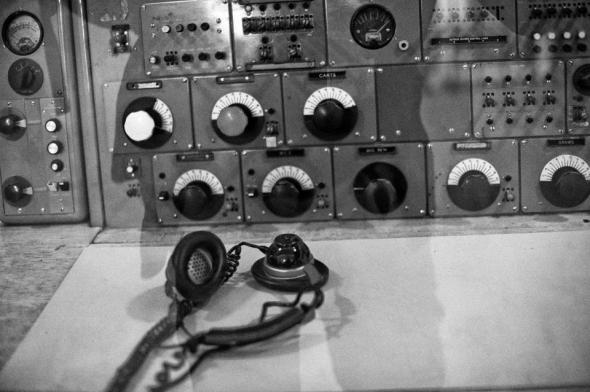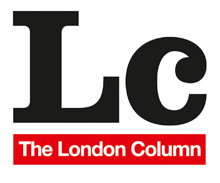New Year’s Eve.
Posted: December 31, 2013 Filed under: London Places, Monumental, Theatrical London | Tags: Denys Lasdun, Royal National Theatre Comments Off on New Year’s Eve. National Theatre from Waterloo Bridge, December 2013. © David Secombe.
National Theatre from Waterloo Bridge, December 2013. © David Secombe.
It’s been a smeary, wind-tossed festive season in London and the UK, and I am in a rush to go to a party in Walthamstow – but by way of farewell to 2013, here is an iPhone image of the National Theatre in which Denys Lasdun’s Brutalist masterpiece resembles a giant boiled sweet.
I don’t know about any of you but I am hoping for better things in 2014: let us hope they start tonight. Thanks to all our readers and contributors and a very Happy New Year.
David Secombe.
Christmas in the city.
Posted: December 24, 2013 Filed under: London Types, Pubs | Tags: Christmas Comments Off on Christmas in the city.The Crown, New Oxford Street. Photo: © Tim Marshall 2013.
Merry Christmas from The London Column.
Bvsh Hovse.
Posted: December 11, 2013 Filed under: Architectural, Corridors of Power, Fictional London, Interiors, Lettering, Literary London, Monumental, Wartime London | Tags: Aldwych, Bogdan Frymorgen, Bush House, Claire Grove, George Orwell BBC, London architecture, Ministry of Truth, Wych Street Comments Off on Bvsh Hovse.Bush House from Kingsway. © Bogdan Frymorgen 2012.
Bush House, the imposing 1920s edifice which dominates the Aldwych and looms over Kingsway, was once declared to be “the most expensive [building] in the world”: by 1929 its construction had cost its American backers £2,000,000. It was built on the site of Wych Street, an ancient survivor of the Great Fire that was ruthlessly destroyed by London County Council circa 1901.
Built of Portland stone, with extravagant use of marble for its cavernous halls, and fronted by forbidding columns surmounted by statues symbolising ‘Anglo-American friendship’, Bush House embodies its era just as much as the Deco Telegraph Building on Fleet Street, or Collcutt and Hemp’s monolithic Adelphi. (The chunk of old London flattened for the Adelphi was the Adam brothers’ graceful riverside development of 1768.) Like the ‘new’ Adelphi, the sheer bombast of Bush House trails unfortunate traces of Fascist architecture; but where Colcutt and Hemp’s stridently moderne behemoth might look at home in Mussolini’s Rome, Bush House’s gigantic faux-classical styling prefigures the more stolid brand of ‘Totalitarian Retro’ that came to be favoured by Hitler and Stalin.
Main entrance. © Bogdan Frymorgen 2012.
© Bogdan Frymorgen 2012.
The BBC established offices in the building in 1941, and for over 70 years Bush House was home to the BBC World Service, originally known as the BBC Overseas Service. George Orwell was a BBC staff member during the war, and the interiors of the building – in particular its canteen – informed his conception of The Ministry of Truth in Nineteen Eighty Four. (It’s clear that the exterior of Orwell’s Ministry was modelled on Senate House in Bloomsbury, and Room 101 was said to be located somewhere in Broadcasting House, but the echoing, labyrinthine interior of Bush House invites us to imagine Winston Smith lost within it.) It might be easy to resent Bush House – for what was sacrificed for its creation, for its monumental scale, and for the sheer absurdity of that portico (which echoes, in the Latin script above its main entrance, the opening titles of a certain famous 1970s TV series: I CLAVDIVS). You could even say that the payoff for the loss of ancient Aldwych is nothing more than a faceless autostrada with a giant conceited lump at its southern end.
© Bogdan Frymorgen 2012.
© Bogdan Frymorgen 2012.
But London is a restless, shape-shifting city, and Bush House has come to stand for more than the pretensions of its sponsors and designers. With the good fortune to house an institution that infused its overblown rhetoric with genuine purpose, it has become a great London building by default. Orwell’s ironic attitude to the BBC aside, during WW2 it acted as a hub for displaced European intellectuals, who broadcast to their besieged home countries from its offices; coded messages aimed at resistance fighters and SOE agents were transmitted to occupied Europe from its studios. It became a symbol of the War Effort. (It was damaged by a V1 flying bomb that hit the Aldwych in 1944; the V1 landed on the Air Ministry directly opposite, leading to worries over the eerie accuracy of those early cruise missiles.)
Even its grandiose classicism may be said to have a claim to authenticity: workmen laying Bush House’s foundations unearthed Roman statuary beneath the dust of Wych Street. A bust of a Roman noble was duly and reverently put on display in the new building’s lobby (even if there are doubts as to its provenance …).
© Bogdan Frymorgen 2012.
These photographs by Bogdan Frymorgen – a studio manager for the World Service – were taken just hours before the BBC finally left Bush House in July 2012, when the humming bustling halls and studios were already silent. Even as a series of absences, they capture a real sense of the urgency and activity that had so recently been going on. They’re full of love for a building and an institution that came to occupy an important place in British cultural history. It’s too easy to forget the esteem in which the BBC World Service is held by its distant listeners; it’s not television – therefore not sexy – but that is what gives it its reach, as radio waves can go anywhere and radios can be found everywhere. The World Service is a unique and magnificent public service; it’s Reithian; and, as such, it’s permanently under threat.
© Bogdan Frymorgen 2012.
But the BBC’s activities at Bush House weren’t confined to the World Service. Amongst other things, a great deal of radio drama was produced there, and in the past weeks I’ve been thinking of this again. A few years ago, I was fortunate enough to spend a few days working on a radio play at Bush House under the aegis of Claire Grove, one of the most innovative and successful radio drama producers of our time. Her funeral was last week. Her Guardian obituary gives a rough idea of her professional brilliance, but it is hard to sum up such a vital person within the confines of an ‘Other Lives’ entry. Lemn Sissay’s appreciation gives some hints of the energy and life that occupied Claire, and indeed Bush House.
Studio 8, cleared out. © Bogdan Frymorgen 2012.
Amidst current refurbishment, Bush House is now occupied by a law firm and HM Customs and Excise. The love really has left the building. D.S. (with K.E-B.)
… for The London Column. Copies of Bogdan Frymorgen’s photographic tribute to Bush House may be ordered from him at frymorgen@googlemail.com or via his Facebook page.










